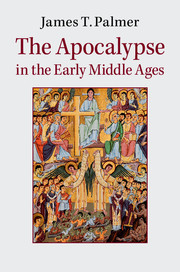Book contents
- Frontmatter
- Dedication
- Contents
- List of figures
- List of maps
- Acknowledgements
- List of abbreviations
- Maps
- Introduction
- 1 The end of civilisation (c. 380–c. 575)
- 2 The new urgency (c. 550–c. 604)
- 3 The ends of time and space (c. 600–c. 735)
- 4 Pseudo-Methodius and the problem of evil (c. 680–c. 800)
- 5 Charlemagne, pater Europae (c. 750–c. 820)
- 6 A Golden Age in danger (c. 820–c. 911)
- 7 The Year 1000 and other apocalypticisms (c. 911–c. 1033)
- Conclusion
- Select bibliography
- Index of manuscript references
- General index
- References
4 - Pseudo-Methodius and the problem of evil (c. 680–c. 800)
Published online by Cambridge University Press: 05 November 2014
- Frontmatter
- Dedication
- Contents
- List of figures
- List of maps
- Acknowledgements
- List of abbreviations
- Maps
- Introduction
- 1 The end of civilisation (c. 380–c. 575)
- 2 The new urgency (c. 550–c. 604)
- 3 The ends of time and space (c. 600–c. 735)
- 4 Pseudo-Methodius and the problem of evil (c. 680–c. 800)
- 5 Charlemagne, pater Europae (c. 750–c. 820)
- 6 A Golden Age in danger (c. 820–c. 911)
- 7 The Year 1000 and other apocalypticisms (c. 911–c. 1033)
- Conclusion
- Select bibliography
- Index of manuscript references
- General index
- References
Summary
While arguments about time persisted, renewed concerns about evil and authority in the world stimulated developments in the West’s apocalyptic repertoire. Few people had fretted about Gog and Magog since Augustine and Jerome’s non-historical interpretation back in the fifth century, even when Gregory the Great had been anxious about the implications of Lombard attacks. Isidore’s celebration of the Goths as heroic descendants of Gog and Magog seemed to complete the Augustinian anti-apocalyptic project on that front. Over the course of the seventh century, however, the Arab conquests of the Middle East and North Africa changed the religious and political map of the Mediterranean, unsurprisingly leading some shocked and disillusioned Christians in the East towards eschatological reflection. What was needed was a strong response from the Byzantine emperor and, as polemics were launched, soon the idea spread that the empire would play a much larger part in End Times narratives than had previously been considered acceptable. The new reflections on evil and authority, pitched in battle against each other, were given popular form in a prophetic sermon by the Syriac Pseudo-Methodius – a work so powerful and adaptable that it was available in Greek and Latin versions across Europe within half a century. Apocalypticism had a new voice and one which would deeply influence medieval traditions.
Information
- Type
- Chapter
- Information
- The Apocalypse in the Early Middle Ages , pp. 107 - 129Publisher: Cambridge University PressPrint publication year: 2014
